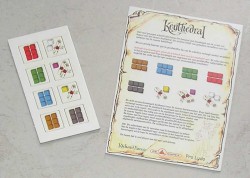 Het goede antwoord op de Keythedral prijsvraag is te vinden in een interview uit 2005 dat Tom Vassal van The Dice Tower had met de ontwerper van Keythedral, Richard Breeze.
Het goede antwoord op de Keythedral prijsvraag is te vinden in een interview uit 2005 dat Tom Vassal van The Dice Tower had met de ontwerper van Keythedral, Richard Breeze.
Uit het interview (de vetgedrukte tekst toont de oplossing):
Tom Vasel: Your games seem to have taken an evolutionary path. One of your early games, Chamelequin, is strictly an abstract game. Is there any reason you veered from games of that genre?
Richard Breese: Chamelequin dates from the late eighties, a time when I was playing games like D&D and Talisman. Whilst Chamelequin is an abstract game, it was actually derived from a movement system I had created for different races – humans, dwarves, etc., to move across different terrains. This was the game I took to Essen in 1991 where I discovered and started to play German games. As I aim to produce games that I enjoy playing, it followed that the subsequent games were in the German style, albeit at the slightly heavier end of the market. My second game, Keywood, actually started life in the corner of the Elfenlands game board.
Van alle inzendingen waren er maar twee goede antwoorden, die mensen hebben een e-mail ontvangen waarin staat dat ze de Keythedral uitbreiding gewonnen hebben.
Wij wensen de prijswinnaars veel plezier met hun prijs en bedanken alle deelnemers voor de inzendingen.
